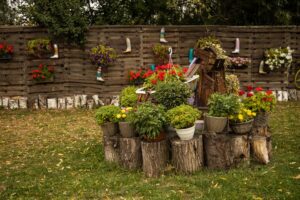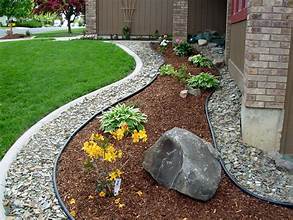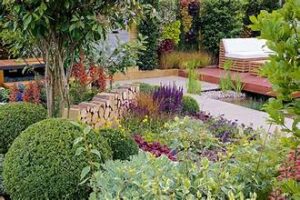
As we move into 2024, sustainability is more than just a trend; it’s a way of life. Homeowners and gardening enthusiasts are increasingly seeking ways to reduce their environmental impact while creating beautiful outdoor spaces. If you’re looking to create an eco-friendly outdoor oasis that aligns with sustainable living practices, you’ve come to the right place. In this guide, we’ll explore sustainable DIY landscaping projects that will help you cultivate a green space in harmony with nature while adding aesthetic value to your home.
Why Choose Sustainable Landscaping?
Sustainable landscaping is all about designing, creating, and maintaining a garden or outdoor space that conserves resources, promotes biodiversity, and reduces waste. Conventional landscaping practices can consume large amounts of water, use harmful chemicals, and result in excessive waste. In contrast, eco-friendly landscaping focuses on reducing carbon footprints, minimizing resource consumption, and using materials that are recycled or sourced from nature.
There are numerous benefits to creating a sustainable outdoor space:
- Lower environmental impact: By using eco-friendly materials and practices, you can minimize your contribution to environmental degradation.
- Water conservation: Sustainable landscapes are designed to use less water, which is critical in regions facing water scarcity.
- Cost savings: Over time, you’ll save money on water, fertilizers, and energy costs.
- Biodiversity enhancement: Native plants and sustainable designs create habitats for local wildlife and pollinators like bees, butterflies, and birds.
Planning Your Eco-Friendly Outdoor Oasis
Before diving into your sustainable DIY landscaping project, it’s essential to plan carefully. Consider your climate, space, and resources. Here’s a step-by-step guide:
1. Assess Your Space and Resources
Understanding your garden’s existing ecosystem is key to making sustainable choices. Identify which areas receive the most sunlight, which have good drainage, and where natural water sources are. Evaluate the types of soil in your garden, as this will help you choose the right plants that will thrive in those conditions with minimal intervention.
2. Use Native Plants
Native plants are those that naturally occur in your region and have adapted to the local environment over thousands of years. These plants are more likely to thrive with less water, fertilizer, and pesticides, making them a sustainable choice. Plus, they help support the local ecosystem by attracting native pollinators like bees and butterflies.
Examples of native plants for different regions:
- For dry climates: Consider succulents, lavender, and sage.
- For temperate zones: Opt for ferns, coneflowers, and black-eyed Susans.
- For tropical areas: Try planting bamboo, hibiscus, and palms.
3. Build a Rain Garden
Rain gardens are a sustainable and visually appealing way to manage stormwater runoff. They are designed to collect rainwater from your roof, driveway, or lawn, allowing it to soak naturally into the soil. This prevents water from overwhelming storm drains and helps filter pollutants before they reach local waterways.
To create a rain garden:
- Choose a low-lying area where water tends to pool.
- Layer the garden with soil, compost, and mulch to promote filtration.
- Plant water-tolerant species such as sedges, blue flag iris, and Joe-Pye weed.
Rain gardens are not only functional but also beautiful, adding texture and color to your outdoor space.
4. Install a Drip Irrigation System
Water conservation is one of the pillars of sustainable landscaping. A drip irrigation system delivers water directly to the roots of your plants, minimizing evaporation and ensuring that each plant gets the right amount of moisture. This method reduces water waste and is ideal for regions prone to drought.
Drip irrigation systems can be easily installed as a DIY project using basic materials:
- Hoses: Connect them to your water source and distribute them around your garden.
- Emitters: These control the water flow to specific plants or areas.
- Timers: Automate your watering schedule to ensure plants receive moisture when needed, typically during the early morning or late evening to reduce evaporation.
5. Use Mulch for Soil Health
Mulch is an essential component of sustainable landscaping. It helps retain moisture, reduce weed growth, and regulate soil temperature. Organic mulch made from wood chips, leaves, or grass clippings is an eco-friendly choice. It gradually decomposes, adding valuable nutrients back into the soil.
To apply mulch:
- Spread a 2-3 inch layer around the base of your plants, being careful not to pile it directly against the stems.
- Reapply as necessary throughout the year to maintain the benefits.
Mulching reduces the need for chemical fertilizers and pesticides, promoting a healthier garden environment.
6. Reuse and Recycle Materials
Sustainable landscaping often involves reusing and repurposing materials instead of buying new ones. For example, old bricks, stones, and even broken tiles can be used to create garden paths or retaining walls. Similarly, wood from pallets or reclaimed lumber can be transformed into raised garden beds or compost bins.
Consider using recycled containers or natural materials to create planters for your garden. Repurposing materials not only reduces waste but also adds a unique, personal touch to your outdoor space.
7. Create a Compost System
Composting is a sustainable practice that reduces organic waste and enriches your garden’s soil. You can easily create a DIY compost bin using repurposed wood or by purchasing a commercial composting unit. Add kitchen scraps (like vegetable peels and coffee grounds) and yard waste (like leaves and grass clippings) to the bin, turning the pile occasionally to promote decomposition.
Compost is rich in nutrients and acts as a natural fertilizer, reducing the need for synthetic alternatives. This helps improve soil structure, retains moisture, and encourages healthy plant growth.
8. Grow a Vertical Garden
If space is limited, consider growing a vertical garden. Vertical gardens use structures such as trellises, walls, or specially designed planters to grow plants vertically, maximizing space and adding a modern, artistic touch to your landscape. These gardens are perfect for small yards or urban spaces.
You can plant vegetables, herbs, or flowers in a vertical garden. Use recycled materials like old pallets or build your own trellises from natural bamboo. This design saves space and makes tending to your plants easier without bending or kneeling.
9. Create Wildlife Habitats
An essential component of sustainable landscaping is fostering biodiversity. You can attract wildlife to your garden by creating habitats for birds, bees, and butterflies. Incorporate elements such as bird feeders, nesting boxes, bee hotels, and water features like small ponds or birdbaths.
Native plants are the foundation for attracting wildlife, as they provide the necessary food, shelter, and breeding ground for local species. A garden filled with vibrant flowers, lush greenery, and buzzing bees is a sign of a healthy, balanced ecosystem.
Conclusion
Creating a sustainable DIY landscaping project in 2024 is about making environmentally conscious choices while designing a beautiful outdoor space. From selecting native plants to incorporating water-saving techniques and reusing materials, each step you take brings you closer to an eco-friendly oasis that supports biodiversity and reduces your environmental footprint.

